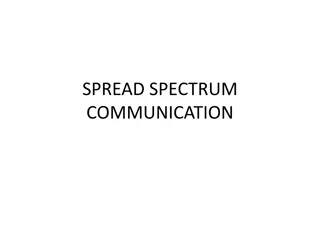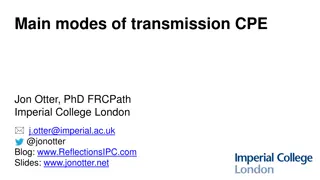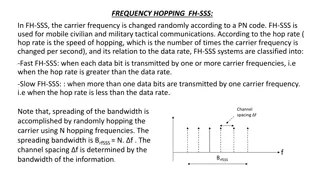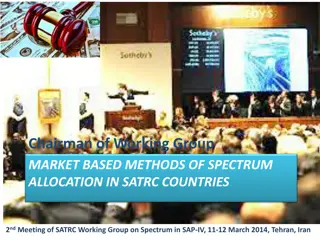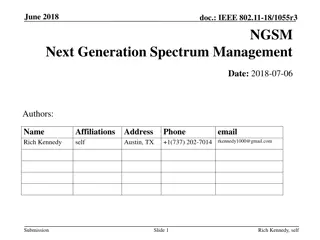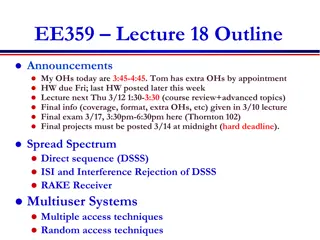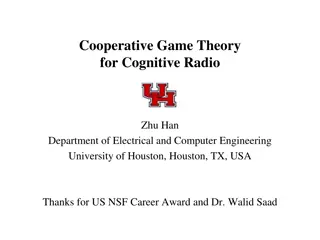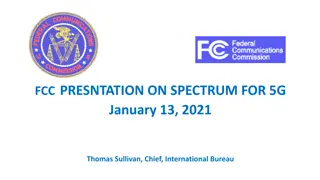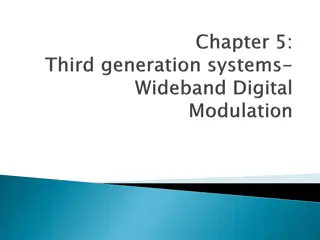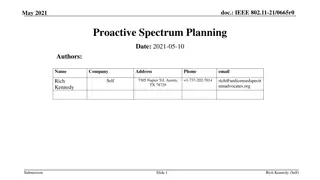Understanding Spread Spectrum Techniques in Data Transmission
Explore the concepts of bandwidth utilization, spreading, and transmission modes in data transmission and digital communication. Learn about spread spectrum techniques such as frequency hopping and direct sequence spread spectrum, which enable efficient sharing of wireless communication channels. Discover how spread spectrum achieves redundancy and independence of the original signal through its spreading process.
Download Presentation

Please find below an Image/Link to download the presentation.
The content on the website is provided AS IS for your information and personal use only. It may not be sold, licensed, or shared on other websites without obtaining consent from the author. Download presentation by click this link. If you encounter any issues during the download, it is possible that the publisher has removed the file from their server.
E N D
Presentation Transcript
Bandwidth Utilization: Spreading + Transmission Modes 2nd semester 1438-1439 NET 205: Data Transmission and Digital Communication
2 205NET CLO 1-Introduction to Communication Systems and Networks architecture OSI Reference Model. 2- Data Transmission Principles 3- Transmission medias 4- Data modulation and encoding 5- Multiplexing 6- Spreading technique 7- Synchronize and asynchronize transmission
3 Outline SPREAD SPECTRUM Frequency Hopping Spread Spectrum Direct Sequence Spread Spectrum TRANSMISSION MODES Parallel transmission Serial transmission asynchronous, synchronous, isochronous
4 SPREAD SPECTRUM
5 Introduction Multiplexing combines signals from several sources to achieve bandwidth efficiency. In spread spectrum, we also combine signals from different sources to fit into a larger bandwidth, but our goals are somewhat different Spread spectrum is designed to be used in wireless applications In these types of applications, stations must be able to share the medium without interception and without jamming .
6 Spread Spectrum Spread spectrum achieves its goals through two principles: The bandwidth allocated to each station needs to be, by far, larger than what is needed. This allows redundancy. The expanding of the bandwidth must be done by a process that is independent of the original signal. In other words, the spreading process occurs after the signal is created by the source. 1. 2.
7 Spread Spectrum Techniques There are two techniques to spread the bandwidth: frequency hopping spread spectrum (FHSS) direct sequence spread spectrum (DSSS)
8 Frequency Hopping Spread Spectrum The frequency hopping spread spectrum (FHSS) technique uses M different carrier frequencies that are modulated by the source signal. At one moment, the signal modulates one carrier frequency. At the next moment, the signal modulates another carrier frequency. .. etc creates a k-bit pattern
9 Example Suppose we have decided to have eight hopping frequencies. M is 8 k is 3 ( k= log2 M). The pseudorandom code generator will create eight different 3-bit patterns. These are mapped to eight different frequencies in the frequency table
10 Example The figure shows how the signal hops around from carrier to carrier. ( assuming the required bandwidth of the original signal is 100 kHz).
11 Bandwidth Sharing If the number of hopping frequencies is M, we can multiplex M channels into one by using the same Bss bandwidth. M different stations can use the same Bss if an appropriate modulation technique such as multiple FSK (MFSK) is used.
12 Direct Sequence Spread Spectrum In direct sequence spread spectrum (DSSS), we replace each data bit with n bits using a spreading code. each bit is assigned a code of n bits, called chips, where the chip rate is n times that of the data bit.
13 Example
14 Bandwidth Sharing We can share the bandwidth, if we use a special type of sequence code that allows the combining and separating of spread signals.
15 TRANSMISSION MODES
16 Introduction The transmission of binary data across a link can be accomplished in either parallel or serial mode. In parallel mode, multiple bits are sent with each clock tick. In serial mode, 1 bit is sent with each clock tick.
17 Parallel Transmission In parallel transmission, the binary data ( 1s and 0s) organized into groups of n bits each and then send data n bits at a time instead of 1.
18 Advantage and Disadvantage The advantage of parallel transmission is speed All else being equal, parallel transmission can increase the transfer speed by a factor of n over serial transmission. The significant disadvantage: cost. Parallel transmission requires n communication lines (wires) just to transmit the data stream. Because this is expensive, parallel transmission is usually limited to short distances
19 Serial Transmission In serial transmission one bit follows another. so we need only one communication channel rather than n to transmit data between two communicating devices
20 Serial Transmission The advantage of serial is that it reduces the cost of transmission over parallel by roughly a factor of n. Serial transmission occurs in one of three ways: asynchronous, synchronous, isochronous.
21 Asynchronous Transmission In asynchronous transmission: the timing of a signal is unimportant It depends on using patterns Patterns are based on grouping the bit stream into bytes.
22 Asynchronous Transmission An example of a pattern: An extra bit (usually a 0) called the start bit is added to the beginning of each byte to alert the receiver to the arrival of a new group. 1 or more additional bits (usually 1 s) called stop bits are appended to the end of the byte to let the receiver know that the byte is finished. By this method, each byte is increased in size to at least 10 bits ( data + synchronization bits). the transmission of each byte may then be followed by a gap of varying duration. This gap can be represented either by an idle channel or by a stream of additional stop bits.
23 Advantage and Disadvantage Slow: The addition of stop and start bits and the insertion of gaps into the bit stream make asynchronous transmission slower than forms of transmission that can operate without the addition of control information. cheap and effective: two advantages that make it an attractive choice for situations such as low-speed communication
24 Synchronous Transmission In synchronous transmission, we send bits one after another without start or stop bits or gaps. It is the responsibility of the receiver to group the bits.
25 Synchronous Transmission The bit stream is combined into longer "frames," which may contain multiple bytes. Bytes is sent sequentially without a gap between it. there may be uneven gaps between frames The receiver is responsible for separating the bit stream into bytes for decoding purposes. There is no built-in mechanism for bit synchronization midstream Timing is very important. The accuracy of the received information is completely dependent on the receiver.
26 Advantage The advantage of synchronous transmission is speed: no extra bits or gaps to introduce at the sending end and remove at the receiving end, and fewer bits move across the link So it is more useful for high-speed applications such as the transmission of data from one computer to another.
27 Isochronous In real-time audio and video, in which uneven delays between frames are not acceptable, synchronous transmission fails. For this type of application, synchronization between characters is not enough; the entire stream of bits must be synchronized. The isochronous transmission guarantees that the data arrive at a fixed rate.
28 Any Questions ?














